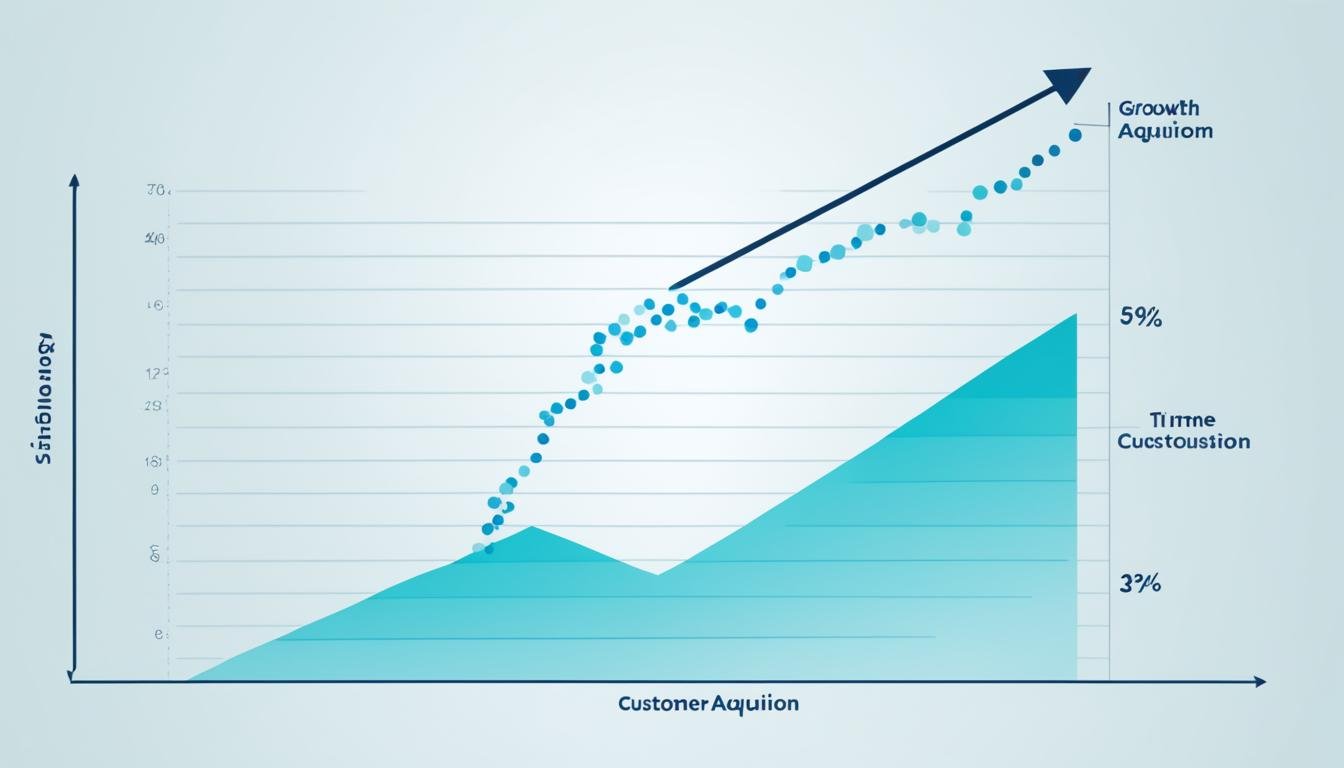Launching a new product or looking to improve your business? Lean analytics is Key Metrics. It’s all about building, testing, and learning from your product. This method is about “failing fast” and making a basic product first.
Then, test it with real people and see what they say. This feedback and data help you improve.
Key metrics are vital for Lean innovation. They help measure your startup’s progress and efficiency. These Key Metrics should match your startup’s goals, giving you real-time feedback.
Key Metrics like profit margins or how much it costs to run your business help you see how you’re doing financially. Looking at how much you spend on marketing or investments helps you use your resources better.
Investors want to see how well a startup is doing. Knowing your key metrics helps you make smart choices. This way, you can improve your business and boost your chances of success in the competitive startup world.
Table of Contents
Understanding the Lean Startup Methodology
The lean startup cycle has three main steps. First, create a minimum viable product (MVP). Then, test it with real customers. Finally, analyze the feedback and data.
This process, called the “build-measure-learn feedback loop,” helps startups quickly check their ideas. They can make smart choices based on data during the product development.
The Build-Measure-Learn Feedback Loop
The lean startup method is all about the build-measure-learn cycle. It stresses the need for fast experimentation, ongoing learning, and being adaptable. By quickly building and testing MVPs, startups learn from customer feedback. They can then tweak their plans.
Actionable vs. Vanity Metrics
At the heart of the lean startup is focusing on actionable metrics. These metrics prove or disprove ideas and guide actions. On the other hand, vanity metrics might boost your ego but don’t tell you much about customer behavior or business health.
By focusing on actionable metrics, startups can make better decisions. This increases their chances of success.
“The Lean Startup approach is not just about spending less money but about putting a structured methodology in place for product development.”
Lean Key Metrics: Actionable vs. Vanity
Tracking metrics for your lean startup is key. It’s important to know the difference between actionable and vanity metrics. Vanity Key Metrics might look good but don’t really help you understand your business. They include things like page views, downloads, likes, and followers.
Actionable metrics, on the other hand, are about what really matters to your business. They help you check if your ideas work and guide your decisions.
Measuring Cause and Effect
Actionable Key Metrics focus on how customers behave, how happy they are, and how likely they are to stay. They also look at revenue. These metrics include things like conversion rate, churn rate, net promoter score, and customer lifetime value. They show you how things affect each other in your business, helping you make smart choices.
What Does the Metric Represent?
It’s important to know what a metric means. Actionable metrics are about specific tasks or features that help your business grow. Vanity metrics might look big but don’t really help you reach your goals.
To pick the right metrics, look for those that are actionable, clear, accessible, auditable, and have a shelf life. This way, you can make choices based on real data that help your business grow.

This image from freepik
| Actionable Metrics | Vanity Metrics |
|---|---|
| Conversion rate, churn rate, net promoter score, customer lifetime value | Page views, downloads, likes, followers |
| Tied to business goals and customer behavior | Focused on exposure, reach, and growth |
| Enable data-driven decisions | Provide impressive numbers without context |
“Good metrics are actionable, clear, accessible, auditable, and have a shelf life.”
Tracking Actionable Metrics
As a lean startup, it’s key to focus on tracking actionable metrics that matter for your stage, goals, and ideas. These include customer acquisition cost (CAC), customer lifetime value (CLTV), revenue growth, churn rate, conversion rate, burn rate, and return on investment (ROI). Keeping an eye on these metrics lets you spot growth chances, use resources wisely, check business ideas, make better decisions, improve products, track progress, boost investor trust, and adjust to market shifts.
Customer acquisition cost (CAC) shows how much it costs to get new customers. Customer lifetime value (CLTV) tells you how much money each customer can bring in. Revenue growth tracks how well your sales and marketing work. Churn rate and conversion rate show where you can get better at keeping customers and engaging them.
“Tracking actionable metrics is essential for lean startups to make data-driven decisions and drive sustainable growth.” – Jane Doe, Startup Advisor
Burn rate and return on investment (ROI) are key for knowing your financial health and how well your marketing and operations work. By keeping a close watch on these metrics, you can make smart choices, refine your plans, and boost your startup’s success chances.

This image from freepik
Balancing Quantitative and Qualitative Data
Building a successful lean startup means finding the right mix of quantitative and qualitative data. Quantitative data, like analytics and surveys, gives us numbers on how much, how many, how often, and how fast things happen. Qualitative data, from interviews and observations, helps us understand why people act the way they do.
The Importance of Qualitative Insights
Quantitative data is key for measuring problems, understanding patterns, and seeing the financial side. But qualitative insights add depth by showing the reasons behind actions. Notes from interviews, focus groups, and usability tests reveal customer problems that numbers alone can’t show.
Yet, qualitative data has its downsides. It can be biased, focus more on attitudes than actions, and takes time to gather. But its value is huge. Mixing quantitative and qualitative data gives entrepreneurs a full picture of their market. This helps them make better choices about product-market fit and customer feedback.

This image from freepik
“The most successful startups balance the use of quantitative data and qualitative insights to drive their decision-making processes.”
Combining quantitative data and qualitative data is key for lean startups. It helps them deeply understand their customers and the market. This leads to smarter, more effective business decisions.
Metric Frequency for Lean Startups
Lean startups need to pick the right frequency for checking key metrics. This helps make smart decisions. The right frequency lets you adapt fast, use resources well, and grab growth chances.
For daily metrics, track important signs like sales, conversion rates, and customer costs. This lets you quickly catch and adjust to changes.
Weekly metrics give you insights into how happy customers are and why they might leave. Checking customer satisfaction and website bounce rates weekly helps spot problems and improve areas.
Monthly metrics show your overall progress and where you stand in the market. Look at website traffic, customer details, market share, and customer value monthly. This helps you see if you’re doing well and find ways to grow.
| Metric Tracking Frequency | Example Metrics |
|---|---|
| Daily | Sales, Conversion Rates, Customer Acquisition Costs, Churn Rates, Website Traffic |
| Weekly | Customer Satisfaction Scores, Website Bounce Rates |
| Monthly | Website Traffic by Channel, Customer Demographics, Market Share, Customer Lifetime Value |
Match your metric tracking frequency with your lean startup’s needs and goals. This way, you get the insights you need to move through the changing market and grow sustainably.

This image from freepik
Lean Metrics for Growth and Optimization
For startups, learning lean metrics is key to growing and optimizing. These metrics help you spot growth chances, use resources wisely, check business ideas, make better decisions, improve your product, track progress, boost investor trust, and adjust to market shifts.
Using both numbers and stories gives a full picture of how customers act and if your product fits the market. The right metrics tracked at the right time help you make choices based on data and stay quick in a fast world.
Leveraging Lean Metrics for Growth
Lean metrics let startups see how their actions affect growth. Key lean metrics to watch include:
- Customer acquisition cost (CAC): Shows how much it costs to get new customers, helping you fine-tune marketing and sales.
- Customer lifetime value (CLV): Figures out how much money a customer will bring in over time, helping you plan for keeping and getting customers.
- Churn rate: Shows how many customers stop using your product or service, helping you find and fix problems.
- Conversion rates: Tells you how well your marketing and sales work in turning leads into paying customers.
Optimizing with Lean Metrics
Lean metrics are also key for making your startup better and improving your product. By tracking things like:
- User engagement: Shows how users use your product, helping you make it better and choose which features to add.
- Retention rate: Keeps track of how many users stick with your product over time, helping you see if it fits the market.
- Net Promoter Score (NPS): Measures how happy customers are, pointing out areas to improve.
- Cycle time: Shows how long it takes to do a task, helping you make your operations smoother and cut waste.
By using lean metrics, startups can make choices based on data, improve how they work, and grow steadily in a tough market.
“The secret to a successful business lies in establishing appropriate metrics for real-time tracking and fostering a culture of operational excellence.”
Conclusion
Starting a business today means you need a plan that’s all about being new, quick, and always getting better. The lean startup way is key. It’s all about building, checking, and learning, and using real numbers to guide you. This helps startups make smart choices, check if their ideas work, and grow in a lasting way.
It’s important to mix numbers and stories, and to track the right metrics often. This keeps startups ahead and helps them make choices based on data. The right metrics for lean startups help founders tackle challenges and boost their success chances.
Adopting the lean startup approach and using real metrics lets entrepreneurs make choices based on facts. This helps them improve their businesses and grow. By focusing on the important metrics, startups can move forward with confidence and reach their big goals.




One Comment on “Key Metrics to Track for Lean Startups 2024”